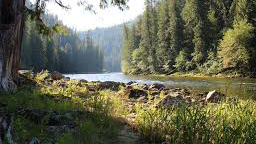American Rivers this week announced America’s Most Endangered Rivers in its 40th annual listing, with Idaho’s Clearwater River Basin ranked the seventh most endangered.
The list:
- Mississippi River: Threatened by FEMA’s uncertain future and role in guiding floodplain protections and maintaining infrastructure that protects river health.
- Tijuana River: Threatened by out-of-control sewage and chemical pollution.
- Rivers of Southern Appalachia: Threatened by extreme weather impacts to unsafe dams and federal capacity to help recovery after recent hurricanes.
- Passaic River: Threatened by historical and rampant industrial pollution.
- Lower Rio Grande: Threatened by a mega-drought and outdated water management.
- Rappahannock River: Threatened by declining groundwater levels and a lack of water supply strategy amidst rapid population growth and expanding industries like data centers.
- Clearwater River Basin: Threatened by loss of 700 miles of Wild and Scenic River candidacy protections.
- Susitna River: Threatened by road construction, mining and pollution.
- Calcasieu River: Threatened by toxic and heavy metal pollutants.
- Gauley River: Threatened by toxic pollution from strip mining for coal in the headwaters.
Idaho’s Clearwater basin includes the North, South and Middle Forks of the Clearwater River. Seven hundred miles of rivers within the basin are at risk from dredge-mining, dam-building and a four-fold increase in commercial logging due to a controversial new land management plan. Some of these rivers have been protected since the 1980s.
“The Clearwater River Basin’s cold, clear, high-elevation streams make it a Noah’s Ark for Chinook salmon, steelhead, and native trout, and it is a cherished destination for boaters and anglers from around the nation,” said Lisa Ronald, Northern Rockies Associate Conservation Director for American Rivers. “To have the Forest Service rescind long standing protections for some of its most remarkable rivers is a betrayal to everyone who loves this area, and all those downstream who depend on its clean water.”
At stake are the administrative protections for the headwaters of the Lochsa River — which joins the Selway River to form the Middle Fork—as well as for the North and South Forks of the Clearwater, all of which have been found to be eligible for designation under the Wild and Scenic Rivers Act. Prior to the new land management plan that was finalized last January, these waterways had been protected for nearly 40 years.
The Lochsa, Selway, and Middle Fork Clearwater rivers are permanently protected as Wild and Scenic Rivers, but the scale of the mining, road-building, and commercial timber harvest that could now occur on the other forks threatens the health of the entire basin, says American Rivers.
“While we understand and appreciate the need for proactive management of our public lands, the Forest Service’s decision prioritizes damaging extractive practices over river protection, endangered fish, and beloved recreation,” said Nick Kunath, Conservation Director for Idaho Rivers United. “This approach is a stark departure from previous processes and severely undermines one of our nation’s most powerful and important river conservation tools.”
Road construction along these rivers would result in increased sedimentation, threatening fish eggs and aquatic insects—while logging in river corridors would remove shade and increase water temperatures, threatening coldwater fish and degrading world-class angling opportunities.
“These rivers are a national treasure that belong to all Americans. It’s painfully obvious to those of us that float these incredible rivers that it doesn’t make sense to roll back their protections just to make logging easier,” notes Kevin Colburn, National Stewardship Director for American Whitewater. “This is not a place to cut corners. The Forest Service should ensure these amazing rivers continue to thrive while managing timber and other resources. They’ve abandoned this reasonable approach.”
American Rivers, Idaho Rivers United, and American Whitewater are calling on the Nez Perce-Clearwater National Forest to: 1) Update the Comprehensive River Management Plan for the Wild and Scenic designated Lochsa, Selway, and Middle Fork Clearwater rivers to provide guidance on how to design projects to ensure these rivers are protected; and 2) Issue a forest plan amendment to provide project-specific guidance to mitigate harm to the 700 miles of streams now at risk throughout the basin.
American Rivers says with half of rivers in the U.S. containing unsafe levels of pollution, “freshwater species going extinct at a faster rate than ocean or land species, and extreme weather driving severe floods and droughts, rivers are among the most threatened ecosystems on the planet. Rivers are also the primary source of drinking water for millions of Americans. They power local businesses, help grow our food, and support fishing, hunting, and other beloved traditions.”
“Our water wealth is one of our greatest assets as a nation,” said Tom Kiernan, president and CEO of American Rivers. “But pollution and extreme weather are putting our rivers, clean water, and public safety at risk. When our rivers our sick, our own health and prosperity suffers. There is still hope for these ten endangered rivers, and rivers nationwide. We must come together to safeguard the rivers and clean water we all depend on.”
American Rivers reviews nominations for America’s Most Endangered Rivers from individuals and organizations across the country. Rivers are selected based upon the following criteria:
- A major decision that the public can help influence in the coming year.
- The significance of the river to people and nature.
- The magnitude of threat to the river and its communities.

